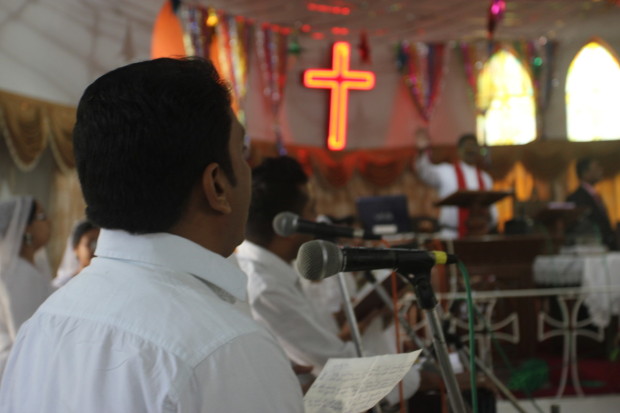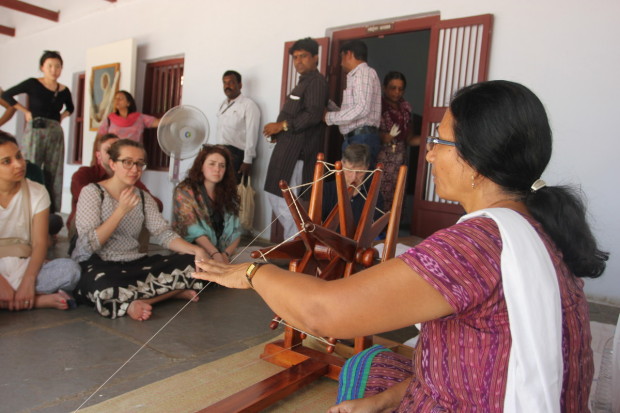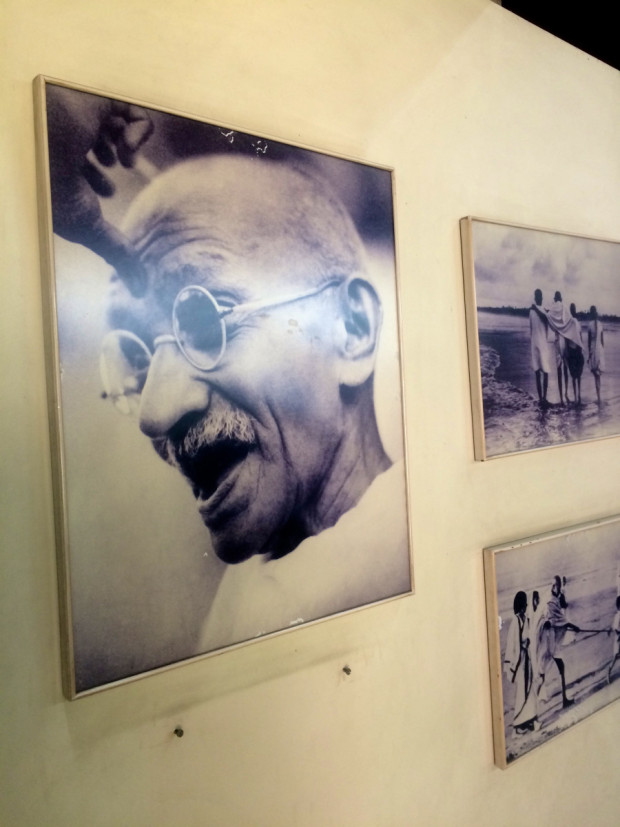ABOARD AIR INDIA FLIGHT 101, FROM NEW DELHI TO NEW YORK – Our final day in India began at a Protestant church in Ahmedabad and ended at the Indira Gandhi International Airport in Delhi where we boarded a flight to New York. I am taking time on the flight to record our day and reflect more broadly on our time together in India.
Our first stop today was at the circular Church of North India in Ahmedabad where the ceiling fans were working overtime to keep the congregation comfortable.
The service was already underway when we entered the church and made our way to the empty seats in front of the sanctuary. There were about 200 worshipers, and they were led by the church pastor, the Rev. Robinson Christian. A small music ensemble, which included a drummer, a harmonium player and a church choir dressed in white, led the congregation in song.
The church was festooned with colorful banners and decorations. Bright plastic ribbons of red, green, blue, yellow and purple crisscrossed the ceiling. The pastor explained that these were the Christmas decorations that the church still hadn’t taken down. With Easter coming, they decided to leave them in place.
The whole service, including the sermon, was in the local language, Gujarati, so most of us were not able to understand the words. But the priest’s hands and energy conveyed his meaning, as he pounded the air and pointed his index finger in different directions. His half-hour sermon was supplemented by PowerPoint slides that he controlled from a laptop next to the pulpit. Slides also provided the congregation with the words of the hymns that they sang.

Devotees sing traditional Indian worship songs during Sunday service at the Church of North India, Ellis Bridge in Ahmedabad, India. Photo by Rachel Lowry.
The pastor said that his family has been Christian for five generations. When we asked him about the recent attacks on Christian churches in the Delhi area, he said that “as an Indian citizen,” he felt sad whenever a religious building is attacked, whether it’s a church, a temple or a mosque.
He said that he felt integrated with the other religious communities—a lot of his friends are not Christians. But when he first meets people, he said he always gets that reaction: “Oh, you’re Christian,” as if he doesn’t completely belong to India. “We have to prove that we are Indians,” he said, as he explained that many times people in India think that Christians aren’t from India. “I belong to Gujarat, I’m Gujarati,” he said.
Most of the songs performed during the worship services were Indian classical songs. Still, Christian feels that his service “is more influenced by Western culture.” For example, he said, Indian devotees would usually sit on the floor; at the Church of North India, they sit on pews.
A few kilometers away, we sat on the floor of the Gandhi Ashram, where Mahatma Gandhi, the preeminent leader of the Indian independence movement, lived from 1918 to 1930. Pratima Vora, our guide, sat cross legged behind a spinning wheel – the same kind of wheels Gandhi encouraged the Indian people to use to counteract the British economic domination of India. What Gandhi wanted, she said, was not mass production, but “production by the masses.”

Pratima Vora demonstrates the spinning of cotton threads at the Sabarmati Ashram in Ahmedabad, India. Photo by Rachel Lowry.
On March 12, 1930, Gandhi left this Ashram, to undertake the Dandi March: he completed 231 miles through India in less than a month. He left the Ashram saying he wouldn’t come back until India was independent. He never returned after 1930.
At the Ashram, the original walking stick of Gandhi was displayed. Close-up pictures and paintings of Gandhi, at different moments of his life, covered several walls. There were quotes praising Gandhi from activists and philosophers including the Rev. Martin Luther King Jr., Albert Einstein and Leo Tolstoy.

Photographs and prints line the walls of a walk-through museum of Gandhi’s life at the Smarak Sangrahalaya Ashram in Ahmedabad, India. Photo by Arielle Dreher.
For our final, celebratory lunch in India, our professors arranged a meal at a revolving restaurant at the top of a hotel so we could enjoy a 360-degree view of Ahmedabad from our seats. We ate from a buffet of dishes including Hawaiian noodles, coconut curry and grilled enchiladas. Professor Goldman thanked Professor Trivedi and our teaching assistant, Aarti Virani, for all that they had done to make the trip a success. And he thanked the class for helping build a supportive team throughout our travels. He recalled standing amid the group on the steps of a Jain temple on Friday and feeling bolstered by all the faculty and students around him. “We created a great community,” he said.
For most of us, our last afternoon was spent buying clothes, spices and other souvenirs. For Jenna, Han and Rachel, these last hours in the country were also the occasion to get henna tattoos on their hands.
Professor Goldman made good use of our hour-long trip to the airport by asking each of us to share a moment of insight from the trip. He noted that we had all written Ritual Moments and Teaching Moments. “Now is the time for your Revelatory Moment,” he said. For Rutwij, it was when a Muslim grocer told him that following Islam meant measuring out exactly 100 grams when he told someone he was giving them 100 grams. Sometimes a bit more, he explained, but never less. Jenna said that the trip helped her realize how religion affected every part of the Indian society and especially the connections between religion and health. Darcy discovered she shared a lot with Indians for whom music was a major path to engage with religion. I got my revealing moment a few hours after we first landed in Delhi: at the Sufi Shrine, a young girl was screaming and running back and forth. She was surrounded by Sufi devotees, who were calmly trying to get a demon out of her body. They told me they had been performing this ritual for a month.
I get to offer some final thoughts about our 11-day journey through northern and western India. As Uncle Ben says in Spiderman, “With great power, comes great responsibility.”
It’s a tough job to sum it all up. We’ve become close during this trip as we’ve experienced India, as a group and individually, through the people we’ve met and the places we visited. But I can confidently give massive thank yous on behalf of our group to our professors who prepared us for this trip for weeks through readings and discussions. Besides planning our collective journey, they were be flexible enough to enable each of us to sometimes leave the group for a few hours, explore, and have our very own India Yatra.
Great final dispatch! The whole group did have a responsibility and I must say it was a pleasure seeing India through the eyes of fellow journalists. Bahut Badhiya!
Hey,this is Viral Vora,son of Pratima Vora(Gandhi Ashram) on behalf of my mother i thank you heartily for writing such a wonderful article.
Only one additional point Gandhiji walked 241 miles (instead of 231 miles quoted in the blog) to break the law of taxing the salt through the Dandi march
If you wish to have any other information do mail me.
Thank you.